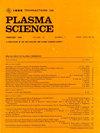轨道炮非匹配网格的迫击炮电磁场数值计算的有限元方法
IF 1.3
4区 物理与天体物理
Q3 PHYSICS, FLUIDS & PLASMAS
引用次数: 0
摘要
轨道炮电枢与轨道处于高速滑动电接触状态,电磁场分布存在速度集肤效应。在此作用下,电流密度局部集中,且在电枢-轨道界面附近较为复杂。为了确保精度,电枢-导轨界面和导轨表面周围的网格尺寸需要足够细。同时,拉格朗日方法通常用于描述涉及运动导体的电磁场,需要一个接近结构化的网格形状。考虑到网格形状的限制,实现一种允许适当和灵活的网格尺寸的网格划分方法是具有挑战性的,这可能导致低效和低精度的模拟。本文介绍了一种有效的非匹配网格划分方法,以获得尺寸合适且灵活的结构化网格。此外,采用Nitsche砂浆有限元法在弱意义上保证了非匹配界面间的连续性条件。该方法在变分公式中加入了附加的边界积分项。对比了30 m/s和100 m/s速度下匹配网格和非匹配网格得到的电流密度结果,验证了非匹配网格方法的正确性和有效性。此外,利用非匹配网格分析了100、500和1000 m/s速度下的电流密度分布,进一步验证了上述方法的可行性。本文章由计算机程序翻译,如有差异,请以英文原文为准。
Nitsche Mortar Finite Element Method for Electromagnetic Field Numerical Calculations With Nonmatching Meshes in Railguns
The railgun’s armature and rail are in high-speed sliding electrical contact, and there is a velocity skin effect regarding electromagnetic field distribution. Under this effect, current density is locally concentrated and is complex near the armature-rail interface. To ensure accuracy, mesh sizes need to be sufficiently fine around the armature-rail interface and the rail’s surface. Meanwhile, the Lagrangian method is commonly used to describe electromagnetic fields involving moving conductors, requiring a nearly structured mesh shape. Given the constraint of the mesh shape, implementing a meshing method that allows for appropriate and flexible mesh sizes is challenging, which may lead to inefficient and low-accuracy simulations. In this article, an efficient nonmatching meshing method is introduced to deliver structured meshes with appropriate and flexible sizes. Furthermore, the Nitsche mortar finite element method is used to ensure the continuity conditions across nonmatching interfaces in a weak sense. This method incorporates additional boundary integral terms into variational formulas. Current density results obtained using matching and nonmatching meshes were compared at velocities of 30 and 100 m/s, proving the correctness and efficiency of the nonmatching meshing method. In addition, current density distribution using nonmatching meshes was analyzed at velocities of 100, 500, and 1000 m/s, further demonstrating the feasibility of the abovementioned methods.
求助全文
通过发布文献求助,成功后即可免费获取论文全文。
去求助
来源期刊

IEEE Transactions on Plasma Science
物理-物理:流体与等离子体
CiteScore
3.00
自引率
20.00%
发文量
538
审稿时长
3.8 months
期刊介绍:
The scope covers all aspects of the theory and application of plasma science. It includes the following areas: magnetohydrodynamics; thermionics and plasma diodes; basic plasma phenomena; gaseous electronics; microwave/plasma interaction; electron, ion, and plasma sources; space plasmas; intense electron and ion beams; laser-plasma interactions; plasma diagnostics; plasma chemistry and processing; solid-state plasmas; plasma heating; plasma for controlled fusion research; high energy density plasmas; industrial/commercial applications of plasma physics; plasma waves and instabilities; and high power microwave and submillimeter wave generation.
 求助内容:
求助内容: 应助结果提醒方式:
应助结果提醒方式:


